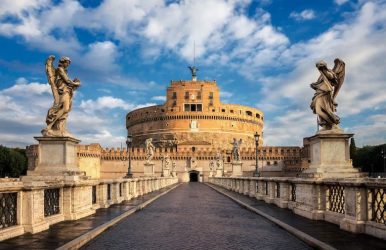The Story Of Castel Sant’Angelo: A Fortress Of History And Culture
BY ArnabMay 12, 2023
Castel Sant'Angelo, a fortress with a rich history and cultural significance, is a must-visit attraction in Rome. Originally built as a mausoleum, it has served as a fortress, prison, and papal residence. Today, it is a museum that houses a collection of art and historical artifacts. You might be missing out on a lot if you have still not booked Pena Palace Tickets. Let us take you to an unbelievable experience of this extraordinary destination. To visit Castel Sant'Angelo, it's essential to purchase Castel Sant'Angelo Tickets in advance, either online or at the entrance. Tickets can be bundled with other attractions or tours for convenience. Once inside, visitors can explore the castle's architecture, including its hidden passages and stunning views of the Tiber River. They can also admire the art and artifacts that have been collected throughout its storied history. In this article, we will delve into the fascinating history of Castel Sant'Angelo and explore its stunning architecture and design. We will also discover the art and culture housed within its walls, uncovering the legends and myths that surround it. We will then examine the efforts to preserve and restore this remarkable landmark. This will help us consider the impact of tourism on its cultural significance. History of Castel Sant'Angelo Emperor Hadrian originally commissioned the Castel Sant'Angelo, also known as the Mausoleum of Hadrian, in 123 AD. It was a mausoleum for himself and his family. However, it later became a military fortress and prison. The castle connected itself to St. Peter's Basilica by a fortified corridor known as the Passetto di Borgo. It was an escape route for Popes during times of danger. Throughout history, Castel Sant’Angelo featured in several significant events. It includes the sack of Rome in 1527 and the trial of Giordano Bruno. He was imprisoned and later executed in the castle. If these reasons are not enough for you to book Castel Santangelo Tickets, we will give you some more. Inside the castle, visitors can explore the various levels and rooms that were once used as prisons, papal apartments, and military quarters. The castle's architecture and design showcase a blend of ancient Roman and medieval styles. Today, Castel Sant'Angelo is a museum that houses a vast collection of art and historical artifacts. It remains a significant symbol of Rome's rich history and cultural heritage. Architecture and Design of Castel Sant'Angelo Castel Sant'Angelo's architecture and design are a blend of ancient Roman and medieval styles. The cylindrical mausoleum features a square base and is topped with a dome and a statue of the Archangel Michael. The castle's exterior has statues and reliefs that depict various mythological figures and Roman emperors. The castle's interior features a spiral ramp that leads to the upper floors and provides access to the various rooms and galleries. The rooms were once used as prisons, papal apartments, and military quarters. Visitors can explore the castle's many levels, including the terrace that offers stunning views of Rome and the Tiber River. The castle's design also includes a fortified corridor known as the Passetto di Borgo, which connects Castel Sant'Angelo to St. Peter's Basilica. This corridor was used as an escape route by Popes during times of danger. Over the centuries, there were various additions and modifications of the castle's design, including the construction of a moat and drawbridge. Despite these changes, Castel Sant'Angelo remains a stunning example of Roman and medieval architecture and is a significant symbol of Rome's rich cultural heritage. Art and Culture at Castel Sant'Angelo Castel Sant'Angelo is not only a magnificent fortress but also a museum that houses a vast collection of art and historical artifacts. The museum's exhibits showcase the castle's rich history and cultural significance, including its use as a mausoleum, military fortress, prison, and papal residence. Among the many treasures housed within Castel Sant'Angelo, visitors can view ancient Roman sculptures, Renaissance paintings, and a collection of weapons and armor. The museum's galleries are also home to rare books and manuscripts, including works by Dante, Petrarch, and Boccaccio. One of the most impressive collections at Castel Sant'Angelo is the Sala Paolina, which features frescoes painted by renowned artists, including Giulio Romano, Perino del Vaga, and Giovanni da Udine. The frescoes depict scenes from the life of Pope Paul III, who commissioned the work. Overall, Castel Sant'Angelo's art and culture provide a fascinating glimpse into Rome's past and showcase the city's enduring cultural legacy. Conclusion Castel Sant'Angelo is a true gem of Rome, combining impressive architecture, rich history, and a fascinating collection of art and artifacts. Originally built as a mausoleum for Emperor Hadrian, the castle has served many purposes throughout its long history, including as a fortress, prison, and papal residence. Today, Castel Sant'Angelo stands as a testament to Rome's enduring cultural heritage and provides visitors with a unique opportunity to explore the city's rich history. Whether admiring the castle's stunning architecture, marveling at the art and artifacts on display, or enjoying the panoramic views of Rome from the terrace, a visit to Castel Sant'Angelo is a must for anyone interested in the city's past and present. Read Also: Top 10 Famous Wonders Of India Where Can You Fully Immerse Yourself In Ancient Culture On Holiday? The Top 5 Reasons To Visit Edinburgh: From Castles To Culture, This City Has It All!










 Latest
Latest




